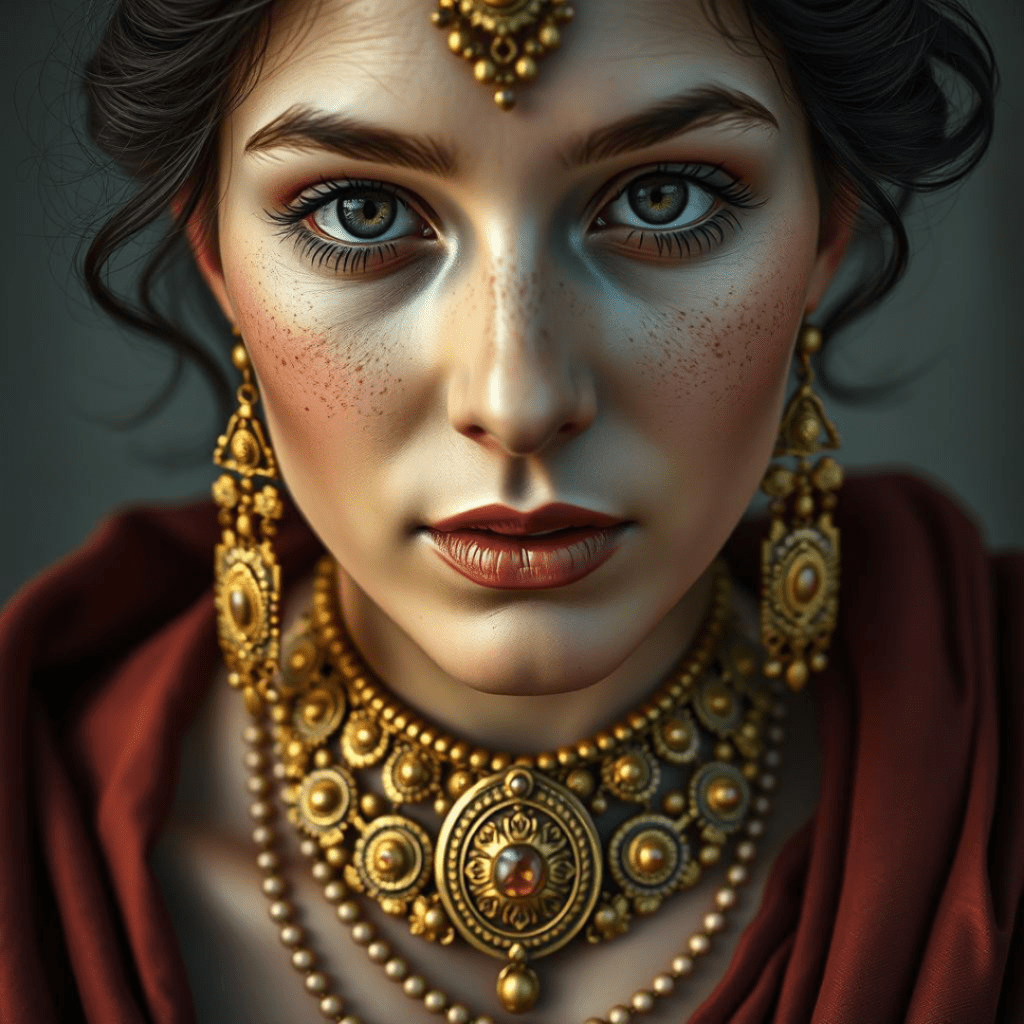Ancient Roman jewelry is a captivating testament to the artistry and cultural significance of its time. These exquisite pieces not only adorned the bodies of the elite but also reflected the social hierarchy and values of Roman society. The craftsmanship involved in creating such jewelry showcased advanced techniques and a deep appreciation for aesthetic beauty.
In this article, we will explore the intricate craftsmanship and rich symbolism behind Ancient Roman jewelry pieces. Each adornment tells a story about the culture and society of the time, revealing insights into daily life, beliefs, and artistic expression.
The Influence of History
The history of Rome, marked by significant events and figures such as Scipio Africanus, has greatly influenced its cultural artifacts, including jewelry. This piece of history is intertwined with the rise and fall of the Roman Empire, a period that not only shaped politics but also left an indelible mark on culture and society.
The Role of Religion
Moreover, the religious practices of ancient Romans were not merely a set of beliefs but a comprehensive system that intertwined with every aspect of their lives. This profound connection between religion and daily life often found its reflection in the jewelry they wore.
Gender Dynamics
It’s also crucial to understand the legal status of women in Rome, as it significantly influenced gender dynamics in ancient Rome, including aspects related to jewelry ownership and usage.
Philosophical Influences
Lastly, the philosophical ideas stemming from Stoicism, which emphasized living in harmony with nature and practicing virtue, may have also influenced the design and use of jewelry during this period.
Discover how these timeless treasures continue to influence contemporary design and capture our imagination today.

The Historical Journey of Ancient Roman Jewelry
The evolution of jewelry in Ancient Rome reflects the broader historical narrative of the Roman Empire. From the Republic (509-27 BC) through to the Empire (27 BC-476 AD), jewelry styles developed significantly, influenced by changing social structures and cultural interactions.
1. Republican Era (509-27 BC)
Initially characterized by simple designs, jewelry primarily made from bronze and iron. As wealth increased, gold began to dominate.
2. Imperial Period (27 BC-476 AD)
The Empire’s expansion led to an explosion of styles and materials. Influences from conquered regions introduced new gemstones and techniques. Artisans began incorporating lavish designs featuring intricate motifs.
Cultural exchanges played a pivotal role in shaping Roman jewelry. Trade routes established through military conquests facilitated the exchange of ideas and craftsmanship across regions. This interaction enhanced the richness and diversity of jewelry designs, with influences seen from:
- Egypt: Use of motifs like scarabs and the incorporation of turquoise in jewelry.
- Greece: Adoption of intricate filigree work.
- Persia: Introduction of colorful gemstones.
These elements combined to create a distinctive aesthetic that defined Ancient Roman jewelry, showcasing not just adornment but also a tapestry of cultural significance intertwined with the Empire’s legacy.
To fully understand this legacy, one must delve into various aspects of ancient Roman life, including the lives of plebeians, who represented the majority and significantly influenced the development of political and economic structures. Additionally, exploring how the Twelve Tables shaped Roman legal systems provides insight into the governance structure during the Republic era. For those interested in more comprehensive resources about Ancient Rome’s fascinating history, Men of Pompeii offers engaging content that brings this past to life.
Moreover, understanding these historical contexts also involves looking at specific styles within ancient jewelry such as Lydian jewelry which showcases some antique styles that have influenced modern perceptions of antique jewelry.
Materials That Adorned Ancient Roman Jewelry
Ancient Roman jewelry showcased a variety of materials, each significantly contributing to the adornments’ aesthetic appeal and societal implications.
Metals
- Gold: The most prized metal, symbolizing wealth and power. Gold jewelry often adorned the elite, accentuating their status within society.
- Silver: Valued for its beauty and malleability, silver played a crucial role in everyday jewelry, accessible to both the affluent and the middle class.
- Bronze: Frequently used for functional pieces, bronze offered durability and was a common choice among lower classes, reflecting a different aspect of Roman life.
Gemstones
- Emeralds: Known for their vibrant green hue, emeralds were associated with fertility and rebirth. They appealed to Romans seeking fortune and protection.
- Garnets: With deep red tones, garnets symbolized love and passion. Their presence in jewelry conveyed personal sentiments beyond mere decoration.
The combination of these materials created intricate designs that did more than adorn; they narrated stories of identity, belief, and societal standing within Ancient Rome.
These stories are intertwined with various aspects of Roman life such as:
- The military prowess that shaped an empire, as seen in The Roman Army.
- The extensive network of Roman Roads which facilitated trade and movement.
- The societal implications of wealth displayed through jewelry could also reflect one’s position in the complex social system that included elements such as gladiatorial games, a popular form of entertainment at the time.
- Understanding how these elements fit into the broader historical context, including significant political shifts like the birth of the Roman Republic, can provide deeper insights into the cultural significance of ancient Roman jewelry.

Techniques Behind Exquisite Craftsmanship
Ancient Roman jewelry is renowned for its intricate designs, a testament to the advanced techniques employed by skilled artisans. Key methods included:
1. Intricate Beading
This technique involved stringing together small beads made from precious materials, creating elaborate patterns. Artisans often used gold, glass, and semi-precious stones to enhance the visual appeal of their creations.
2. Filigree Work
A hallmark of Roman craftsmanship, filigree involves twisting fine wires of gold or silver into delicate, lace-like designs. This technique allowed for the creation of lightweight yet visually striking pieces that showcased the artisans’ skill and attention to detail.
The significance of craftsmanship in Ancient Roman jewelry extends beyond aesthetics. High-quality construction ensured durability, allowing these pieces to withstand the test of time. Jewelry was not just an accessory but also a reflection of status and wealth within society.
Jewelry adorned with meticulous craftsmanship served as a means of personal expression and social signaling. The labor-intensive processes involved in creating these pieces enhanced their value, making them cherished possessions among Romans. The legacy of this craftsmanship continues to inspire contemporary artisans today, echoing the elegance and sophistication of ancient designs.
Diverse Types of Jewelry in Ancient Rome
Ancient Roman jewelry displayed a remarkable variety, with rings and earrings being among the most popular types. Each piece served distinct functions, showcasing both ornamental beauty and practical utility.
Rings
- Ornamental vs. Functional: Rings were often adorned with intricate designs for decorative purposes but also served functional roles.
- Signet Rings: These rings featured engraved designs used to authenticate documents. They held significant social value, signifying status and authority.
- Wedding Rings: Symbolized love and loyalty, often inscribed with personal messages or symbols that conveyed deep sentiments.
Earrings
- Variety of Styles: Earrings came in various forms including hoops, studs, and pendants. They were crafted from materials like gold and gemstones to enhance their appeal.
- Cultural Significance: Beyond adornment, earrings indicated social status and fashion trends within different classes of Roman society.
Jewelry pieces not only adorned the body but communicated personal identity and societal roles. The craftsmanship evident in these items highlights the importance placed on aesthetics and symbolism in Ancient Rome. This rich diversity provides insight into the cultural fabric of the time, paving the way for further exploration of their deeper meanings.
The daily life in Ancient Rome was vastly different for the various social classes, especially the patricians and plebeians. This social class divide significantly influenced fashion trends, including jewelry styles.
Moreover, the spectacle of ancient Rome was not just limited to politics or warfare; it also extended into the realm of entertainment which played a crucial part in shaping social relationships.
In exploring these aspects of ancient Roman life through a journey through time, one can gain a deeper understanding of how jewelry was more than just an accessory; it was a reflection of one’s social status, personal identity, and even involvement in the grand spectacles that characterized ancient Roman society.
Symbolism Embedded Within Ancient Roman Adornments
Ancient Roman jewelry is rich with symbolism, often reflecting the beliefs and values of Roman society. Various motifs were commonly used, each carrying deeper meanings:
- Snakes: Symbolized rebirth and immortality, a potent representation of transformation.
- Doves: Associated with love and peace, often depicted in wedding jewelry.
- Laurel leaves: Signified victory and achievement, commonly seen in adornments for military leaders.
Jewelry also served a protective role as amulets, believed to ward off evil spirits or bring good fortune to the wearer.
Notable examples include:
- Garnet amulets: Thought to guard against misfortune.
- Gold rings inscribed with protective incantations: Designed to shield the wearer from harm.
This intertwining of beauty and belief elevated jewelry beyond mere decoration. Each piece was a testament to personal identity and societal norms, reinforcing status while echoing cultural narratives. The intricate designs reflected not only artistic skill but also a deep connection to the spiritual realm.
Such artistry is further explored in the context of Art and Culture in Ancient Rome, where the remarkable artistic expressions heavily influenced by earlier Greek and Etruscan traditions are highlighted. In this way, Ancient Roman jewelry transcended its physical form, embodying layers of meaning that resonated through generations.
The economic backdrop of this period also played a significant role in shaping these artistic expressions. The role of agriculture in Roman economic growth extended beyond mere food production, influencing various sectors including art and jewelry making.
The Role of Jewelry in Funerary Practices and Status Representation
Jewelry played a significant role in the funerary customs of Ancient Rome. It served as a powerful symbol that communicated the social status, profession, and personal identity of the deceased.
Burial Practices
Jewelry was often included in burial sites, reflecting the belief that these items would accompany the individual into the afterlife. Wealthy Romans frequently had their favorite pieces placed with them, ensuring they maintained their status even in death. This practice is well-documented in various Roman funerary practices, which detail how personal belongings were integral to burial customs.
Status Indicators
Different types of jewelry indicated various ranks within society. For instance:
- Gold and Gemstone Adornments: Reserved for elite individuals, these pieces signified wealth and high social standing.
- Simple Bronze or Glass Items: Common among lower classes, they represented more modest lifestyles.
Professional Symbols
Certain jewelry types also denoted specific professions. For example, tools or motifs related to one’s trade could be integrated into designs, allowing others to recognize the individual’s societal role.
This integration of jewelry into funerary practices not only showcased individual identity but also reinforced societal structures within Ancient Rome. These adornments carried deep meaning, acting as a bridge between life and death while preserving the legacy of those who wore them. Such themes are explored in depth in studies about Roman funeral rituals and social status, shedding light on how these customs reflected broader societal norms and values.
Trade Networks: Connecting Cultures Through Jewelry Exchange
Ancient Rome’s extensive road network played a crucial role in the trade and distribution of jewelry throughout its vast empire. This infrastructure not only facilitated the movement of goods but also fostered cultural exchange among different regions. Key aspects of this exchange include:
1. Trade Routes
The intricate web of roads connected major cities and provinces, allowing artisans and merchants to travel and share their craft.
2. Cultural Influences
As jewelry traveled along these routes, it absorbed elements from various cultures, resulting in diverse styles and techniques. For instance, Eastern motifs found their way into Roman designs, enriching the overall aesthetic.
3. Materials Exchange
Precious metals and gemstones were sourced from different parts of the empire. The availability of varied materials contributed to unique jewelry creations that reflected regional characteristics.
The road network enabled not just the flow of commodities but also ideas. Artisans learned from one another, leading to innovations in design techniques such as intricate metalwork and gemstone settings. This interconnectedness allowed Roman jewelry to evolve continually while maintaining high standards of craftsmanship. The legacy of these trade networks is evident in how they shaped jewelry-making practices in the regions influenced by Roman culture.
Enduring Legacy: Influence on Contemporary Design and Artisanship Appreciation Today
Ancient Roman jewelry continues to inspire modern artisanship, reflecting its enduring legacy in contemporary design. Key elements of Roman craftsmanship are evident in today’s jewelry, with artisans incorporating:
- Intricate designs: Techniques such as filigree and beading remain popular, allowing for the creation of stunning pieces that echo ancient aesthetics.
- Symbolic motifs: Popular themes from Roman jewelry, like nature-inspired elements and mythological figures, resonate with modern sensibilities.
The influence of Roman mythology on contemporary culture is evident in these symbolic motifs. Examples abound in the work of contemporary jewelers who draw upon this rich heritage. For instance, modern engagement rings often feature classical styles reminiscent of Roman signet rings, evoking timelessness while symbolizing commitment.
Collectors and enthusiasts place immense value on historical artistry. The appreciation for ancient techniques and designs fuels a thriving market. Jewelry made using traditional methods commands higher prices due to its craftsmanship and cultural significance.
Museums showcasing ancient Roman collections inspire new generations of artisans, ensuring that the skills and stories behind this jewelry endure. As modern artisans continue to explore historical influences, they keep the spirit of Ancient Rome alive through their creations.
Moreover, the legacy of Roman law and its enduring influence on modern legal systems is another testament to the lasting impact of ancient Rome. This influence extends beyond just law into various aspects of contemporary society, showcasing the comprehensive reach of Roman heritage.
Additionally, the remarkable engineering feats accomplished by the Romans have laid down a foundation for modern infrastructure systems, further underlining their profound influence on today’s world.
Conclusion
The legacy of ancient Roman jewelry lives on through its incredible craftsmanship and deep meaning. Each piece tells a story about the artistry and cultural values of its time, showcasing the strong bond between adornment and personal identity.
- Appreciate the Beauty: These timeless adornments are not just visually pleasing; they also hold stories that link us to a fascinating historical narrative.
- Explore Symbolism: Roman jewelry offers glimpses into societal beliefs and practices, with protective amulets and status symbols as prime examples.
We encourage readers to explore further into the world of Ancient Roman Jewelry: Craftsmanship and Symbolism Revealed. By engaging with these artifacts, we can develop a greater appreciation for their beauty while also paying tribute to the skilled artisans who imbued them with significance.
It’s essential to remember that these artifacts are part of a broader narrative encompassing Roman architecture, which showcases remarkable feats of ancient engineering. Each piece represents a journey through history, inviting us to forge connections between the past and present.
FAQs (Frequently Asked Questions)
What is the significance of Ancient Roman jewelry in history?
Ancient Roman jewelry holds great historical significance as it reflects the intricate craftsmanship and rich symbolism of the time. These adornments tell stories about the culture and society of Ancient Rome, showcasing values such as status, wealth, and beliefs.
What materials were commonly used in Ancient Roman jewelry?
Common materials used in Ancient Roman jewelry included gold, silver, bronze, and various gemstones like emeralds and garnets. These materials not only enhanced the beauty of the pieces but also conveyed social status and wealth among wearers.
What techniques were employed by artisans to create Ancient Roman jewelry?
Skilled artisans utilized advanced techniques such as intricate beading and filigree work to craft exquisite designs. The importance of craftsmanship played a crucial role in elevating both the aesthetic value and durability of these remarkable jewelry pieces.
What types of jewelry were popular in Ancient Rome?
Different types of jewelry were popular in Ancient Rome, including rings and earrings. Each type had specific functions and styles, with unique features such as signet rings used for authentication purposes.
What symbolism is found within Ancient Roman jewelry?
Ancient Roman jewelry often featured common motifs, such as snakes representing rebirth. Additionally, many pieces served as protective amulets believed to ward off evil spirits or attract good fortune for the wearer.
How did trade networks influence Ancient Roman jewelry exchange?
Rome’s extensive road network facilitated trade and distribution of jewelry across its vast empire. This connectivity fostered cultural exchange among different regions, leading to diverse designs that enriched Ancient Roman adornments.

